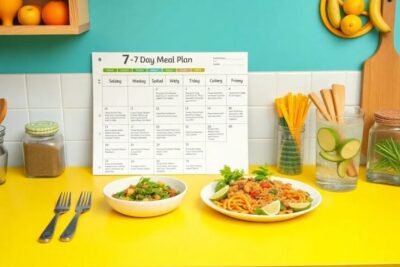
Understanding the Diabetic-Friendly Brat Diet
- Introduction to the Brat Diet
- Why Choose a Diabetic-Friendly Version of the Brat Diet?
- Key Components of the Diabetic-Friendly Brat Diet
- Benefits of the Diabetic-Friendly Brat Diet
- How to Implement the Diabetic-Friendly Brat Diet
- Common Misconceptions about the Brat Diet and Diabetes
- Consulting with Healthcare Professionals
- Real-Life Success Stories
- Frequently Asked Questions
Introduction to the Brat Diet
The Brat Diet, an acronym for Bananas, Rice, Applesauce, and Toast, has long been recognized for its utility in addressing digestive discomfort, particularly in cases of diarrhea and gastrointestinal distress. This simple diet is notable for its bland nature and low fiber content, which makes it easy on the stomach and helps to reduce irritation. However, for individuals with diabetes, the Brat Diet takes on an additional layer of significance. Maintaining stable blood sugar levels is paramount for those managing this condition, and certain components of the Brat Diet can contribute positively to this goal.
When considering the inclusion of bananas, rice, applesauce, and toast in a diabetic-friendly brat diet, it is important to understand how each food item affects blood glucose levels. Bananas are rich in potassium and essential nutrients, although their natural sugar content necessitates monitoring portion sizes. Whole grain toast can serve as a source of carbohydrates while providing more fiber than its white counterpart, which can aid in glycemic control. Applesauce, commonly used for its soothing properties, can also be blended with healthful spices to enhance flavor without adding excessive sugars.
Furthermore, white rice, while traditionally a staple of the Brat Diet, can potentially lead to rapid spikes in blood sugar for diabetics. Therefore, brown rice or other whole grain alternatives may serve as more appropriate options. It is crucial for individuals following a diabetic-friendly brat diet to focus on moderation and balance, integrating these foods into a broader diet that prioritizes overall health and blood sugar management. By carefully selecting and portioning foods, those with diabetes can utilize the Brat Diet not only as a remedy for digestive issues but also as a means to maintain their well-being.
Why Choose a Diabetic-Friendly Version of the Brat Diet?
The traditional BRAT diet, consisting of bananas, rice, applesauce, and toast, serves as a common recommendation for those experiencing gastrointestinal disturbances. While this diet can effectively alleviate symptoms such as diarrhea and vomiting, it may not be suitable for individuals with diabetes in its original form. The necessity of adapting the BRAT diet for diabetics stems from the impact various carbohydrates have on blood sugar levels.
Bananas, for example, are a staple in the traditional BRAT diet due to their high potassium content and digestibility. However, it is important to note that bananas can also be quite high in sugar, which can lead to spikes in blood glucose levels. Similarly, white rice, a primary carbohydrate source in the BRAT diet, possesses a high glycemic index, meaning it can rapidly raise blood sugar levels. Consequently, while the original BRAT diet may be advantageous for general digestion, those with diabetes must opt for a modified version to manage their condition effectively.
To create a diabetic-friendly BRAT diet, alternatives to high-sugar and high-glycemic index foods should be integrated. Options such as whole grain toast, which offers more fiber and a lower glycemic response, can replace refined toast. Additionally, opting for low-sugar applesauce is a prudent choice for those monitoring their glucose levels. By selecting these modifications, individuals can still enjoy the advantages of the BRAT diet while minimizing the risks associated with diabetes.
In light of these factors, it's evident that a diabetic-friendly version of the BRAT diet is essential for individuals managing diabetes. By making mindful food choices, one can effectively navigate the path to recovery from gastrointestinal issues without compromising blood sugar control.
Key Components of the Diabetic-Friendly Brat Diet
The diabetic-friendly brat diet is an adapted version of the traditional brat diet, which typically consists of bananas, rice, applesauce, and toast. In this context, each component serves a purpose, aligning with the dietary needs of individuals managing diabetes while promoting gut health. Adopting low-glycemic index options within each category can be particularly beneficial for sustaining balanced blood sugar levels.
Starting with bananas, they are rich in fiber and potassium, essential for overall health. For those on a diabetic-friendly brat diet, opting for slightly less ripe bananas can be advantageous. Unripe bananas have a lower glycemic index compared to fully ripened ones, which can help maintain more stable blood glucose levels. The soluble fiber found in bananas also aids in digestion, making them a fitting choice for individuals with gastrointestinal concerns.
Next, rice is a common staple in the brat diet. However, switching from white rice to brown rice or wild rice can enhance its nutritional value. These whole grain options contain higher fiber content, which not only promotes a healthy digestive system but also assists in modulating blood sugar levels. Such alternatives align with the principles of a diabetic-friendly brat diet by offering lower glycemic responses.
Applesauce serves as an easily digestible food option. For a diabetic-friendly adaptation, choosing unsweetened varieties is imperative to avoid added sugars. Further, incorporating fiber-rich apples into the diet, rather than solely relying on applesauce, can provide additional nutrients and lower the glycemic impact.
Finally, toast can be an excellent base for various toppings. Whole grain or sprouted grain bread options are preferable as they offer enhanced fiber content and slower digestion, contributing to better blood sugar management. Combining these components judiciously creates a balanced approach that adheres to the principles of the diabetic-friendly brat diet, catering to both digestive health and glucose control.
Benefits of the Diabetic-Friendly Brat Diet
The diabetic-friendly brat diet is an advantageous approach tailored to suit the nutritional needs of individuals managing diabetes. This diet primarily includes bananas, rice, applesauce, and toast—collectively referred to as the BRAT diet. One of the primary benefits of this adaptation is its positive impact on digestive health. The components of the diabetic-friendly brat diet are often low in fiber, making them gentle on the stomach, which can be particularly beneficial during moments of gastrointestinal stress or after experiencing nausea. This gradual approach aids in the stabilization of gut health, making it a practical choice for those dealing with digestive issues associated with diabetes.
In addition to improving digestive health, the diabetic-friendly brat diet plays a significant role in nutrient absorption. Bananas and applesauce provide essential vitamins and minerals, such as potassium and vitamin C, which can enhance overall health. The simplicity of this diet also ensures that individuals manage their blood sugar levels more effectively. By focusing on easily digestible foods with controlled carbohydrate content, individuals can maintain steadier blood sugar levels, mitigating the risk of spikes and crashes that often accompany high-sugar or high-fiber foods.
Moreover, this diet is particularly useful for those recovering from illness, as it offers a gentle way to reintroduce food while still considering the dietary restrictions that come with diabetes management. The predictable nature of the diabetic-friendly brat diet not only alleviates concerns regarding blood glucose variability but also allows individuals to monitor their responses to these specific foods. Overall, the benefits of utilizing a diabetic-friendly brat diet can greatly contribute to improved health and an enhanced wellness journey, making it a thoughtful choice for those needing to address both diabetes and digestive concerns.
How to Implement the Diabetic-Friendly Brat Diet
Incorporating the diabetic-friendly brat diet into your daily life involves careful planning and consideration of meal choices. The brat diet, traditionally consisting of bananas, rice, applesauce, and toast, can be tailored to fit the nutritional needs of individuals managing diabetes. When implementing this diet, it is crucial to focus on portion control and choose whole grain or low-sugar options where possible.
To start, consider meal planning for the week. Begin by integrating small portions of bananas, which provide natural sweetness and essential nutrients without causing significant spikes in blood sugar levels. Pair this with brown rice, which is a healthier alternative to white rice and offers fibrous benefits that can improve digestion and regulation of blood sugar. Applesauce is another component; opting for unsweetened varieties ensures reduced sugar intake while still allowing enjoyment of this smooth, nutritious option. Additionally, whole grain toast can serve as a healthy base for a variety of toppings, from nut butters to avocado, adding richness without excessive carbohydrates.
It's also important to explore creative and diabetes-friendly recipes that utilize these brat diet staples. For example, consider a banana oat pancake that includes mashed bananas and oats, which can be cooked in minimal oil for a satisfying breakfast option. Likewise, rice can be transformed into a savory dish with the addition of low-sodium vegetables and lean proteins, providing not only variety but also nutritional balance.
Moreover, to assist in the successful integration of these foods into your existing dietary pattern, maintain a food journal to track your meals and responses to different foods. This practice can provide insights into how you can adjust portions and combinations for optimal blood sugar control. By thoughtfully incorporating the elements of the diabetic-friendly brat diet, you can create a delicious and manageable meal plan that supports your health goals.
Common Misconceptions about the Brat Diet and Diabetes
The Brat Diet, consisting of Bananas, Rice, Applesauce, and Toast, has long been promoted as a gentle nutrition plan for those experiencing nausea, gastrointestinal distress, or recovery from illness. However, its association with diabetes often leads to a variety of misconceptions that require clarification. One significant misunderstanding is that the Brat Diet is exclusively high in carbohydrates and therefore unsuitable for individuals with diabetes. While it is true that the components of this diet contain carbohydrates, the focus should be on portion control and the nutritional context of these foods.
Another prevalent myth is that following a diabetic-friendly Brat Diet means sacrificing taste or variety. In reality, individuals can incorporate a wider array of foods that fit within the BRAT framework while positioning themselves to maintain stable blood glucose levels. For example, using whole-grain toast or integrating low-sugar applesauce can enhance fiber content and provide essential nutrients while minimizing drastic blood sugar spikes. Thus, adaptability towards healthier alternatives is crucial in redefining the Brat Diet's role in diabetes management.
Additionally, some believe that the Brat Diet is solely beneficial for those without diabetes. On the contrary, when tailored appropriately, it can be an effective dietary strategy for those managing blood sugar levels. This includes ensuring that each component is balanced with protein and healthy fats to create a satisfying meal that can help prevent overeating. Therefore, anyone considering the diabetic-friendly Brat Diet should consult a healthcare professional or a registered dietitian, who can assist in customizing the plan to suit individual dietary needs while concluding that a well-structured approach can enhance overall health without compromising the primary objectives of diabetes management.
Consulting with Healthcare Professionals
When considering significant changes to one’s dietary habits, especially for individuals living with diabetes, consulting with healthcare professionals is of utmost importance. A diabetic-friendly brat diet, which typically consists of bananas, rice, applesauce, and toast, can be a beneficial approach for managing gastrointestinal distress. However, it may not suit every individual's health needs or medical history. Thus, engaging with a healthcare provider ensures that any dietary alterations are safe and tailored to personal circumstances.
To begin, it is essential for patients to have open and honest discussions with their dietitians or doctors regarding their specific diabetes management goals. This could involve detailing existing health conditions, medications being taken, and previous experiences with diets. By providing this information, healthcare professionals can adequately assess whether a diabetic-friendly brat diet is appropriate and determine how best to incorporate it into one’s daily routine.
Moreover, healthcare professionals can offer insights into portion control and the potential need for additional food items that may increase nutritional value without adversely affecting blood sugar levels. They can also guide individuals on how to monitor their body’s response to new foods. Patients can ask pertinent questions, such as how often they should consume these foods, what alternative options are available if certain items do not suit their taste, and how to pair brat diet components with other foods to ensure balanced nutrition.
In summary, the collaborative approach between patients and healthcare providers when transitioning to a diabetic-friendly brat diet can lead to more effective management of diabetes and overall well-being. Engaging healthcare professionals ensures that dietary changes align with individual health goals and promote a sustainable lifestyle change, ultimately enhancing the quality of life for those living with diabetes.
Real-Life Success Stories
The diabetic-friendly brat diet, consisting of bananas, rice, applesauce, and toast, has been transformative for many individuals managing diabetes. One such success story comes from Jane, a 45-year-old woman who struggled with fluctuating blood sugar levels for years. After consulting her nutritionist, Jane decided to adopt the diabetic-friendly brat diet as a starting point for her meal plans. Initially skeptical, she found that incorporating these easily digestible foods helped stabilize her blood sugar levels significantly. Over three months, Jane reported not only improved glucose readings but also enhanced overall energy and mood.
Another inspiring story is that of Mark, a 32-year-old father of two, who faced daily challenges due to his type 2 diabetes. Mark turned to the diabetic-friendly brat diet during a particularly rough patch when he was struggling to maintain his weight and energy. By following this simple and structured diet, he began to see positive changes in his health. He experienced reduced cravings for unhealthy snacks, which paved the way for better food choices, ultimately leading to weight loss and better glycemic control. Mark credits the brat diet for changing his relationship with food and empowering him to take charge of his health.
Finally, we have Maria, a retired school teacher who found success with the diabetic-friendly brat diet after her diagnosis. With a focus on easy-to-digest foods, Maria was able to incorporate the brat diet into her daily routine alongside other wholesome foods. She learned to create balanced meals that kept her satisfied while ensuring her glucose levels remained stable. The positive benefits she has reaped include improved digestion and increased vitality, motivating her to encourage friends and family to embrace similar dietary changes. These testimonials shine a light on how the diabetic-friendly brat diet can foster significant improvements in managing diabetes while providing practical inspiration for others on a similar journey.
Frequently Asked Questions
The diabetic-friendly brat diet is designed to provide nourishment while managing blood sugar levels. Many people have questions about this dietary approach, so let's address some common inquiries surrounding it.
What does the BRAT in brat diet stand for? The acronym BRAT refers to bananas, rice, applesauce, and toast. These foods are traditionally recommended for gastrointestinal distress because they are bland and easy to digest. For those with diabetes, modifications ensure that the brat diet remains suitable, such as incorporating whole-grain options and balancing carbohydrate intake with protein and healthy fats.
Can I include other foods in the diabetic-friendly brat diet? Yes, while the traditional BRAT elements are central to this diet, it can be adapted to include other foods that are low in sugar and high in nutrients. Options such as low-fat yogurt, lean proteins, and non-starchy vegetables can enhance satiety and provide essential vitamins and minerals without causing blood sugar spikes.
Is the diabetic-friendly brat diet suitable for everyone? The diabetic-friendly brat diet may not be appropriate for all individuals. Those with specific medical conditions or complex dietary needs should consult a healthcare professional or registered dietitian before making significant changes to their diet. Personalized adjustments can help cater to individual health requirements while ensuring effective blood sugar management.
How long should one follow the diabetic-friendly brat diet? This diet is typically recommended for short-term use, primarily during episodes of gastrointestinal discomfort. However, if you are considering this diet for long-term management of diabetes or weight, it's advisable to seek guidance from a healthcare provider. They can help outline a plan that ensures sufficiency in nutrients while adhering to blood sugar control.
By addressing these common questions, individuals can make informed decisions regarding the diabetic-friendly brat diet and integrate it into their overall dietary strategy effectively.










